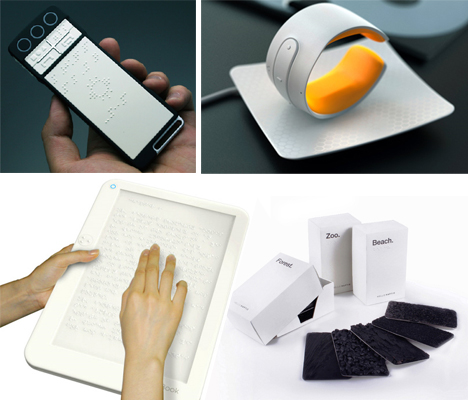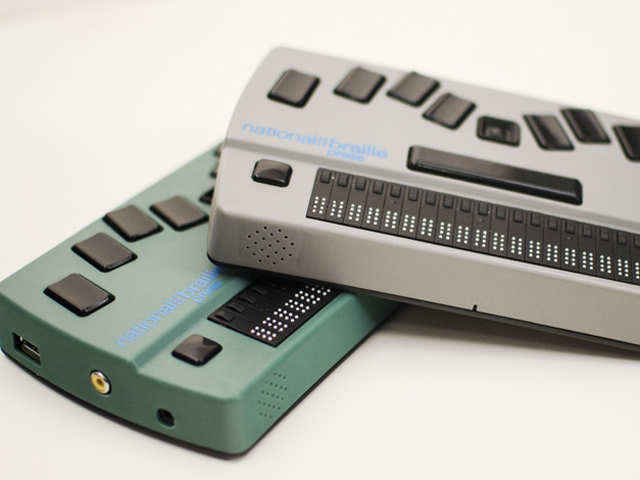Mobility Aids for Visually Impaired Users: Improving Freedom
Mobility Aids for Visually Impaired Users: Improving Freedom
Blog Article
Discover Innovative Devices Developed for the Visually Impaired
The growth of ingenious devices for the aesthetically impaired represents a significant advancement in access and self-reliance. Technologies such as wise glasses with AI capacities and mobile applications made to provide auditory descriptions are reshaping everyday experiences for users. Furthermore, wearable tools that use haptic responses boost environmental understanding, while contemporary Braille developments provide brand-new means to engage with text. As these devices proceed to advance, their effect on the lives of those with visual problems elevates essential concerns concerning the future of inclusivity and autonomy in various elements of life. What lies ahead in this technological landscape?
Smart Glasses for Navigation

Smart glasses created for navigation are changing the way visually damaged individuals engage with their environment. These sophisticated devices utilize a combination of cam modern technology, expert system, and auditory responses to give real-time details concerning environments. By employing challenge detection systems, wise glasses can alert customers to possible hazards, enabling much safer mobility in both acquainted and strange setups.
The assimilation of GPS innovation further boosts navigating abilities, enabling individuals to get auditory instructions as they relocate. This hands-free method not only fosters independence but additionally equips visually damaged individuals to browse city landscapes with raised confidence. Additionally, several clever glasses are geared up with features that determine spots and road indications, providing contextual details that improves the user experience.
Moreover, the growth of these tools is constantly advancing, with companies working to boost the accuracy of things recognition and increase the array of navigational attributes. As wise glasses come to be a lot more inexpensive and easily accessible, they hold the prospective to significantly change every day life for aesthetically damaged users. Eventually, these innovative devices represent a crucial action toward inclusivity, offering improved wheelchair and a better sense of freedom for people navigating the world around them.

Mobile Apps for Daily Living
Exactly how can mobile applications boost the day-to-days live of visually damaged people? Mobile applications are changing the means visually impaired individuals navigate their atmospheres, handle everyday tasks, and access information. These applications offer vital support through different performances, promoting freedom and boosting lifestyle.
Several ingenious mobile applications are made particularly for everyday living. Apps like Be My Eyes link visually damaged users with sighted volunteers using video calls, allowing them to obtain real-time support with tasks such as reading labels or browsing unfamiliar spaces. In A Similar Way, Seeing AI, established by Microsoft, makes use of expert system to describe environments, read text, and determine objects, effectively changing a mobile phone into an effective tool for everyday aid.
In addition, navigation applications tailored for the aesthetically damaged, such as Aira and BlindSquare, offer audio-based directions and environmental information, allowing customers to traverse their surroundings safely and confidently. Beyond navigation and prompt assistance, mobile apps additionally support company and job monitoring, with functions that assist individuals establish suggestions, develop order of business, and track visits. In summary, mobile applications serve as essential resources, equipping aesthetically damaged people to lead even more independent and fulfilling lives.
Wearable Technologies for Help
Empowerment with technology is progressively evident in the world of wearable devices created to aid visually impaired individuals. These ingenious tools incorporate seamlessly into every day life, enhancing navigating and giving essential responses to customers. Smart glasses equipped with cameras can check out and recognize faces message aloud, enabling customers to connect even more with confidence in social and professional setups.
Another notable innovation is the use of haptic feedback systems in wearable the original source tools. These systems use vibrations or various other tactile signals to convey details regarding the user's atmosphere, such as challenges or changes in surface, boosting flexibility and security. Wearable innovations also include wristbands that link to mobile phones, alerting individuals to notifications via subtle vibrations, thus boosting connectivity without dependence on visual hints.
As these modern technologies continue to develop, they are not only enhancing independence for aesthetically impaired individuals yet also cultivating a higher feeling of inclusion in culture. By bridging the space in between challenges encountered in day-to-day living and the potential for freedom, wearable technologies act as critical devices in the quest for equal rights and empowerment for those with aesthetic impairments.
Audio Summary Devices
Audio summary devices play a crucial function in improving availability for visually damaged people, supplying them with the ability to involve with aesthetic media. Voice-activated assistive devices. These tools supply narrated descriptions of crucial visual components in films, television shows, and live performances, guaranteeing that individuals can fully understand the context and feelings conveyed with visuals
Sound summary can be incorporated into different platforms, consisting of streaming solutions, cinema screenings, and live theater. Numerous prominent streaming services currently include audio description as an ease of access feature, enabling viewers to choose it conveniently. Along with mainstream media, specialized applications likewise exist, providing audio descriptions for art exhibitions, museums, and other cultural occasions.
The efficiency of audio summary rests on the skill of the storytellers, that must cheap glasses frames convey visual details succinctly without detracting from the original sound. Technologies in this area are also paving the way for even more individualized experiences, where customers can readjust the degree of detail and pacing according to their preferences.
Braille Innovations and Instruments
Braille developments and tools have actually significantly transformed the means visually damaged individuals connect with text and details. Modern developments have resulted in the growth of functional tools that boost literacy and independence amongst customers. Notably, Braille show modern technologies have actually progressed, enabling dynamic reading experiences. These gadgets transform electronic text into Braille, making it possible for users to access a huge selection of information on computers, tablet computers, and smartphones.
Furthermore, portable Braille notetakers combine traditional Braille input with modern-day capabilities, facilitating note-taking, organizing, and record modifying on the go. Mobility aids for visually impaired users. These portable tools usually feature text-to-speech capabilities, bridging the gap in between Braille and auditory details
In enhancement, ingenious Braille printers have arised, enabling users to generate Braille labels, documents, and instructional materials successfully. This accessibility cultivates greater involvement in professional and instructional environments, ultimately advertising inclusivity.
Additionally, research right into smart Braille innovations continues to increase. Tools that incorporate expert system are being explored to supply real-time navigation help and contextual details, improving the individual experience in varied settings. On the whole, these advancements show a dedication to empowering aesthetically damaged people with innovation, guaranteeing they can easily gain access to and involve with the globe around them.

Conclusion
The advancement of innovative devices for the aesthetically impaired considerably enhances self-reliance and quality of life. Smart glasses, mobile applications, wearable modern technologies, audio summary devices, and Braille advancements collectively empower people by supplying vital navigation aid, ecological understanding, and improved analysis experiences. These innovations not just foster greater incorporation but additionally promote autonomy in everyday activities, inevitably contributing to an extra easily accessible and equitable society for aesthetically impaired people. Proceeded development in this area holds guarantee for more enhancements.
As clever glasses end legally blind up being extra easily accessible and economical, they hold the prospective to dramatically transform daily life for visually damaged users. Mobile apps are reinventing the way visually impaired individuals browse their environments, handle everyday tasks, and access info. Applications like Be My Eyes link aesthetically impaired users with sighted volunteers through video clip telephone calls, allowing them to receive real-time support with tasks such as checking out tags or browsing unknown rooms.In addition, navigating applications customized for the aesthetically damaged, such as Aira and BlindSquare, supply audio-based directions and environmental information, allowing individuals to traverse their environments securely and with confidence.The innovation of ingenious tools for the visually impaired dramatically boosts freedom and top quality of life.
Report this page